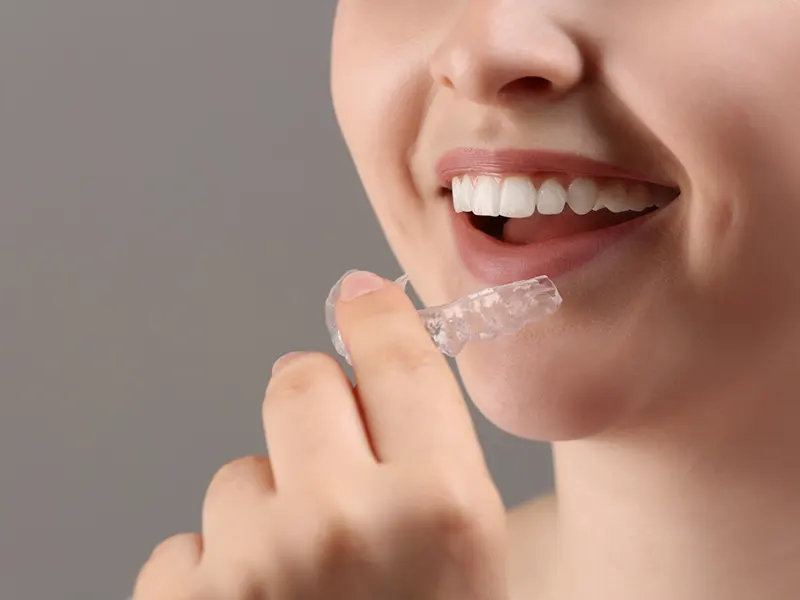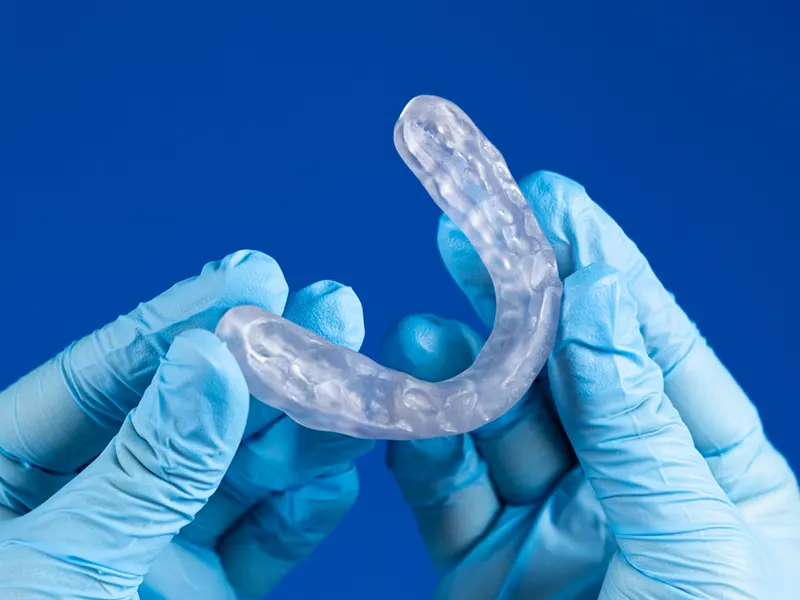

Dentist made night guards for bruxism
Occlusal Splint

Occlusal Splints: Your Complete Guide to Protecting Your Smile and Easing TMJ Pain
Are you waking up with a sore jaw, experiencing frequent headaches, or noticing that your teeth seem more worn than they should be? You might be dealing with bruxism (teeth grinding) or temporomandibular joint (TMJ) disorders. If these symptoms sound familiar, an occlusal splint might be the solution you’re looking for. In this comprehensive guide, we’ll explore everything you need to know about occlusal splints, from what they are to how they can benefit your dental health and alleviate TMJ-related issues.

What is an Occlusal Splint?
An occlusal splint, also known as a dental occlusal splint or night guard for bruxism, is a custom-made dental appliance designed to protect your teeth and jaw from the harmful effects of teeth grinding and clenching. This removable device is typically worn while you sleep, creating a barrier between your upper and lower teeth to prevent damage and reduce strain on your jaw muscles and joints.
Key Features of Occlusal Splints:
- Custom-fitted to your mouth for maximum comfort and effectiveness
- Made from durable, high-quality materials (usually acrylic or thermoplastic)
- Designed to be worn primarily during sleep
- Can help alleviate symptoms associated with temporomandibular joint (TMJ) disorders
Understanding TMJ and Its Relationship to Occlusal Splints
The temporomandibular joint (TMJ) is the hinge that connects your jaw to your skull. TMJ disorder can cause pain in the jaw joint and the muscles controlling jaw movement. These disorders can be caused by various factors, including:
- Teeth grinding or clenching (bruxism)
- Arthritis in the TMJ
- Jaw injury
- Chronic stress leading to facial muscle tension
Occlusal splints play a crucial role in managing TMJ disorders by:
- Reducing pressure on the jaw joint
- Preventing teeth grinding and clenching
- Promoting proper jaw alignment
- Relaxing facial muscles
By addressing these factors, occlusal splints can significantly reduce TMJ pain and improve overall jaw function.

Why Might You Need an Occlusal Splint?
Occlusal splints are primarily recommended for people who suffer from bruxism or temporomandibular dysfunction (TMD). Here are some signs that you might benefit from an occlusal splint:
- Worn, flattened, or chipped teeth
- Increased tooth sensitivity
- Jaw pain or soreness, especially in the morning
- Frequent headaches, particularly tension headaches
- Earaches not caused by an infection
- Clicking or popping sounds when opening or closing your mouth
- Limited jaw movement or locking of the jaw
- Facial pain or soreness
- Neck and shoulder pain
- Disrupted sleep (for you or your partner due to grinding noises)
Additionally, if you have extensive porcelain crowns or bridgework and are prone to bruxism, an occlusal splint is essential for protecting these restorations. Porcelain is durable but can still be damaged by the forces of grinding and clenching. An occlusal splint acts as a safeguard, helping to maintain the integrity and longevity of your dental work.
If you’re experiencing any of these symptoms, it’s essential to consult with your dentist. They can evaluate your condition and determine if an occlusal splint is the right treatment option for you.
Book an appointment at one of 6 MC Dental clinics in Melbourne.
Over 35 bilingual dentists available 7 days a week.
Call us on 03 8608 8968
or book online by clicking on the button below.
The Benefits of Using an Occlusal Splint
Investing in an occlusal splint can offer numerous benefits for your oral health, TMJ health, and overall well-being:
1. Protect Your Teeth
The primary function of an occlusal splint is to create a barrier between your upper and lower teeth, preventing the damaging effects of grinding and clenching. This protection can help:
- Reduce wear on tooth enamel
- Prevent chips and cracks in teeth
- Maintain the integrity of dental work such as crowns or fillings
2. Alleviate TMJ Pain and Muscle Tension
By properly positioning your jaw and absorbing the forces of grinding and clenching, an occlusal splint can:
- Reduce strain on the temporomandibular joint
- Decrease tension in facial and neck muscles
- Help alleviate TMJ-related pain and discomfort
- Improve jaw mobility and function
3. Improve Sleep Quality
For many bruxism sufferers and their partners, teeth grinding can disrupt sleep. Wearing an occlusal splint can:
- Reduce grinding noises
- Promote more restful sleep
- Potentially decrease snoring in some cases
4. Prevent More Serious Dental and TMJ Issues
By addressing bruxism and TMJ problems early with an occlusal splint, you can potentially avoid more serious issues down the line, such as:
- Severe tooth wear requiring extensive restorative work
- Jaw misalignment
- Chronic TMJ disorders requiring surgical intervention
- Development of sleep disorders
Types of Occlusal Splints
There are several types of occlusal splints available, each designed to address specific needs:
- Hard Acrylic Splints: The most common type, offering durability and effective protection against heavy grinding. These are often preferred for severe bruxism and TMJ issues.
- Soft Splints: Made from a more flexible material, these can be more comfortable for some users but may not be as durable for severe grinders.
- Hybrid Splints: Combining a hard outer layer with a soft inner lining, these offer a balance of comfort and durability.
- Full Arch Splints: Cover all teeth on either the upper or lower arch. These are typically used for general bruxism and TMJ issues.
- Partial Splints: Cover only some of the teeth, often used for specific bite issues or localised TMJ problems.
- Anterior Deprogrammers: These splints only cover the front teeth and are designed to help relax the jaw muscles and reprogram muscle memory in cases of severe TMJ disorders.
Your dentist will recommend the best type of splint for your individual needs based on factors such as the severity of your grinding, jaw alignment, TMJ symptoms, and personal comfort preferences.
The Process of Getting an Occlusal Splint
Obtaining a custom occlusal splint typically involves the following steps:
- Dental Consultation: Your dentist will examine your teeth and jaw, discuss your symptoms, and determine if an occlusal splint is right for you. This may include a specific evaluation of your TMJ.
- Impressions or Scans: Accurate moulds or digital scans of your teeth will be taken to ensure a perfect fit.
- Fabrication: Your splint will be custom-made based on your dental impressions, usually by a dental laboratory.
- Fitting: Once your splint is ready, you’ll return to the dentist for a fitting. They’ll ensure it fits comfortably and make any necessary adjustments.
- Follow-up: Your dentist will schedule a follow-up appointment to check how you’re adapting to the splint, assess any changes in your TMJ symptoms, and make any further adjustments if needed.
Occlusal Splint Cost: What to Expect
The cost of an occlusal splint can vary depending on several factors:
- The type of splint recommended
- The materials used
- Your geographic location
- Whether you have dental insurance coverage
- The complexity of your TMJ issues
On average, you can expect to pay between $300 to $800 for a custom-made occlusal splint. For more complex cases involving severe TMJ disorders, the cost might be higher due to the need for additional diagnostics or specialised splint designs.
While this might seem like a significant investment, it’s important to consider the long-term benefits and potential savings in future dental work and TMJ treatments that might be avoided by protecting your teeth and jaw now.
Many dental insurance plans offer partial coverage for occlusal splints, especially when they’re deemed medically necessary for TMJ treatment. It’s worth checking with your insurance provider to understand your coverage options.
Caring for Your Occlusal Splint
To ensure your occlusal splint lasts as long as possible and remains hygienic, follow these care tips:
- Clean your splint daily with cool water and a soft toothbrush.
- Avoid using hot water, as it can warp the splint.
- Store your splint in its case when not in use to protect it from damage and keep it clean.
- Bring your splint to your regular dental check-ups for professional cleaning and inspection.
- If you notice any changes in how your splint fits or any damage, contact your dentist immediately.
- Keep track of any changes in your TMJ symptoms and report them to your dentist.
Alternatives and Complementary Treatments to Occlusal Splints
While occlusal splints are highly effective for many people with bruxism and TMJ issues, they’re not the only solution. Some alternatives and complementary treatments include:
- Botox injections to relax jaw muscles
- Stress management techniques and relaxation exercises
- Physical therapy for jaw muscles
- Dental work to correct bite issues
- Medications for pain management or muscle relaxation
- Acupuncture or massage therapy
- Cognitive behavioural therapy to address stress-related bruxism
Your dentist or TMJ specialist can help you explore these options and create a comprehensive treatment plan that may include an occlusal splint along with other therapies.
Conclusion: Protecting Your Smile and Easing TMJ Pain with Occlusal Splints
Occlusal splints offer a simple yet effective solution for protecting your teeth from the damaging effects of grinding and clenching while also providing relief from TMJ-related pain and discomfort. By investing in a custom-fitted splint, you’re not just safeguarding your smile – you’re also taking a proactive step toward better overall oral health, improved jaw function, and enhanced quality of life.
If you’re experiencing symptoms of bruxism or TMJ disorders, don’t wait to seek help. Consult with your dentist about whether an occlusal splint might be the right choice for you. Remember, every smile and jaw is unique, and the best treatment plan is one tailored to your individual needs.
Take action today to protect your teeth, ease your TMJ pain, and wake up to a healthier, pain-free smile tomorrow! Book your appointment with MC Dental anytime.
Book an appointment at one of 6 MC Dental clinics in Melbourne.
Melbourne Central | Westfield Doncaster | Docklands | Glen Waverley | Brighton | Highpoint
Call us on 03 8608 8968
or book online by clicking on the button below.
FAQ – Occlusal splints cost, use and therapy
Most people adapt to wearing an occlusal splint within a few days to a couple of weeks. Initially, you may experience increased salivation or a slight change in speech, but these effects are temporary. Consistency in wearing the splint as directed by your dentist will help you adjust more quickly.
While occlusal splints are primarily designed for nighttime use, some people may benefit from daytime wear, especially if they clench their teeth during stressful situations. Always consult with your dentist before wearing your splint during the day, as they can advise you based on your specific needs.
A properly fitted occlusal splint should not permanently change your bite. The splint is designed to protect your teeth and jaw, not to alter your dental alignment. If you notice any changes in your bite after wearing a splint, consult your dentist immediately.
With proper care, an occlusal splint can last anywhere from 2 to 5 years. However, you should have your splint checked at every dental appointment (typically every 6 months) to ensure it still fits properly and is in good condition. Your dentist will advise you when it’s time for a replacement.
Yes, children can use occlusal splints if recommended by a dentist. Bruxism is common in children, and in some cases, a custom-fitted splint may be necessary. However, as children’s mouths are still growing, they may need replacements more frequently than adults.
Coverage varies depending on your insurance plan. Many dental insurance plans provide partial coverage for occlusal splints, especially when they’re deemed medically necessary (e.g., for treating diagnosed TMJ disorders). Check with your insurance provider for specific details about your coverage.
While over-the-counter mouth guards are less expensive, they are not as effective or comfortable as custom-made occlusal splints. Custom splints are precisely fitted to your mouth, providing better protection and comfort. They’re also made of more durable materials. For long-term use, especially for TMJ issues, a custom splint is generally recommended.
While an occlusal splint is not primarily designed to stop snoring, some people may experience reduced snoring as a side effect. This is because the splint can help position the jaw in a way that keeps the airway more open. However, if snoring is your primary concern, it’s best to consult with a sleep specialist who can recommend more targeted treatments.
It’s generally not recommended to eat while wearing your occlusal splint, as this can damage the splint and may not be comfortable. Drinking water is usually fine, but avoid hot beverages that could warp the splint. Always remove your splint before eating and brush your teeth before putting it back in.
Yes, occlusal splints can be made for people who wear dentures. These splints are specially designed to fit over dentures and provide the same protective benefits. Your dentist can create a custom splint that works with your specific type of dentures.
Signs that your splint may need adjustment include:
- Discomfort or pain when wearing the splint
- The splint feels loose or too tight
- You notice increased teeth grinding or jaw pain
- The splint shows signs of excessive wear
If you experience any of these issues, schedule an appointment with your dentist for an evaluation.
Yes, for many people, occlusal splints can help reduce the frequency and intensity of headaches, especially those caused by teeth grinding or TMJ disorders. By reducing muscle tension and improving jaw alignment, splints can alleviate one of the common causes of tension headaches and migraines.



